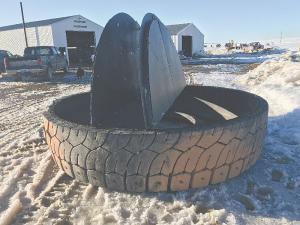2018 - Volume #42, Issue #3, Page #28
[ Sample Stories From This Issue | List of All Stories In This Issue | Print this story
| Read this issue]
“No Power” Water Tank Never Freezes
 |
 |
“Stock tank heating systems, whether propane, wood or electric, cost a lot to run, are high maintenance, and are a safety issue,” says Williamson. “We saved $2,500 a year in electricity alone by getting rid of our electric tank heaters. With our Geothermal Rubber Tire Tank Insert, no matter what the weather, our water systems are operating.”
Williamson runs cattle on his own ranch and does consulting with other cattlemen, setting up grazing systems. That means designing, if not also installing, fencing and watering systems.
“We figured there had to be a better way, so we developed one and have spent the past 3 1/2 years fine-tuning it,” says Williamson.
Williamson started with the standard large rubber tire tank that is popular on a lot of livestock operations. Most include a standard float system tied to a valve on a pipe stub sticking out of the concrete base. He added a 10-ft. long, 3-ft. dia., length of heavy-duty plastic culvert insert to the concept.
With Williamson’s system, the insert is placed vertically 10 ft. into the ground with the rubber tire tank above it. The water pipe is brought into the culvert at the bottom, delivering 52-degree water. As it circulates up through the culvert, which is also conducting heat from the surrounding earth, it naturally warms the water throughout the tank. Even if no new water is being introduced, as water cools at the surface, it drops to the bottom and circulates back up as it is warmed.
A quick coupler valve on the water pipe at the bottom of the culvert, but ahead of the float valve, can be disconnected from above with a one-hand release. While the female end remains inside a vertical pvc pipe, the male end can be pulled out. Any service work on the float or its valve can be done above ground and away from the water and then easily reinstalled.
“With a standard hydrant, if you have problems you have to backhoe out the hydrant,” says Williamson. “With ours, drop in a pump, empty the tank and the insert, and you can get in and do the repairs.”
Even with the ground-warmed water, extreme cold can shut down a tank at the surface. For those conditions, Williamson devised an insulated tank lid. It consists of a 2-in. thick steel frame with 2 layers of plastic sandwiching a layer of poly insulation.
The lid has multiple opening options from a single door to a combination of quarter and half doors. Some or all can be left open depending on the number of cattle to be watered and the time of the year. A limited access drinking hole lets cattle drink even in subzero weather while leaving other lids closed.
“If you have 20 head and a 12-ft. tank, you may need only one door open, but with 100 head in the summer, you might leave both halves open,” says Williamson.
It is in extreme cold that the tank insert and lid system really shine. “We’ve had tanks sit for 2 winters with no livestock,” says Williamson. “You may get some ice buildup around the tire, but not where the float is.”
While Williamson’s company will install the tanks with lids and inserts, he is also selling the inserts and lids for installation outside his area. Inserts for 9 to 15-ft. dia. tanks sell fro $2,400. Lids for 13-ft. dia. tanks sell for $2,100.
“We can ship them for a local contractor to install,” says Williamson. “We recommend the use of an auger to install the culvert. It creates less disturbance and eliminates the need to compact the soil around the tank.”
Contact: FARM SHOW Followup, Bud Williamson, P.O. Box 13, Moorcroft, Wyo. 82721 (ph 307 680-4595; customranchservices.com).

Click here to download page story appeared in.

Click here to read entire issue
To read the rest of this story, download this issue below or click here to register with your account number.




